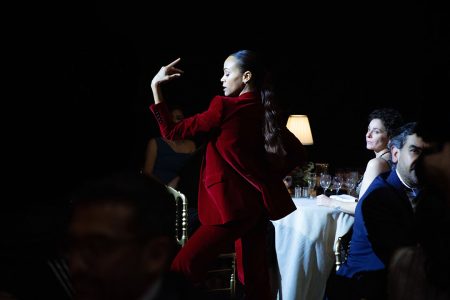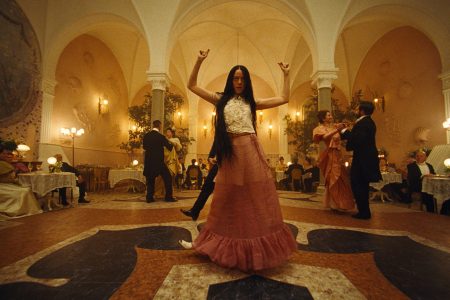‘We were so shocked and wondered what was happening,’ said my parents over the phone. ‘We looked at each other and said: I think it’s contemporary dance!’ They were recounting the final sequence of the crime thriller series Giri/Haji, excited at identifying the art form. Not having seen it yet, I promised to watch it on Netflix and get back to them to confirm their suspicions.

article
Dance+: Giri/Haji

Translating from Japanese as Duty/Shame, Giri/Haji follows two central protagonists: Detective Kenzo Mori and his brother Yuto, whom he believes to be deceased. After a few episodes it transpires that Yuto is in fact alive, living in London, and has recently killed the son of a Tokyo Yakuza boss. Having been made to look like the work of a rival gang leader, the murder causes discord between the Tokyo gangs, who threaten to launch bloody warfare if the true culprit isn’t revealed and brought back to Japan. The task to find Yuto falls to Kenzo who, during his trip to London, ends up torn between personal and professional duties.
After a whirlwind eight episodes featuring a variety of subplots – including a run-in with the Albanian mafia, and Kenzo’s daughter Taki running away from home to join her father in the UK, befriending troubled but lovable rent boy Rodney in the process – the series climaxes on a London rooftop, with one character – no spoilers! – considering jumping to their death. As they stumble, a group of others run to catch them and the screen fades to black and white, signifying a transition into a more abstract realm. Melancholic string music ensues, and the characters engage in a variety of dramatic movement sequences.
While it may seem like a tall order to ask untrained dancers to break out into movement, the naturalistic, interaction-based choreography by Liam Steel – a core member of DV8 Physical Theatre from 1992 to 2000 and, more recently, the choreographer behind film and stage productions including Tom Hooper’s film of Les Miserables and the Birmingham Rep’s theatre production of The Wizard of Oz – makes it easy for the actors to adapt, especially considering that physical theatre is a style many of them may have encountered at drama school.

The scene choreographically reflects on the narrative of the entire series

Focusing on interpersonal relationships and emotions rather than the intricacies of the Yakuza plot, the scene choreographically reflects on the narrative of the entire series, starting with a duet between Kenzo and Yuto. Supportive lifts and counterbalances are performed alongside aggressive hand grips and shoves, the contrasting movements poetically depicting their ambivalent relationship.
Other characters are introduced into view. The brothers’ late father appears, arms outstretched towards Yuto, his favoured son, causing Kenzo to reel off in dejection. He rolls into the back of his London love interest, who tenderly cups his face and spirals around his body, until they are broken up by Kenzo’s daughter Taki, distressed by her father’s infidelity. She subsequently gets caught up in a strained trio with her father and mother who, imprisoned by each other’s limbs, stare at each other with steely eyes. It’s an effective portrayal of how children can bind couples together, even when they realise that they possibly no longer should be.
Meetings between characters continue to run seamlessly, until, over time, a cosmos of coexisting interactions and interceptions is revealed. The camera lens – almost like a choreographed dancer itself—orbits around the characters, its continuous motion creating a sense of temporal progression allowing events that had occurred over numerous years to be deftly recounted in a scene lasting no more than three minutes. At times, the camera gets up close and personal, showing the emotion in the actors’ eyes and the intricacies of their movements – whether their touches are tender or strained, for example. At other times, it pans out to give a bird’s-eye view, to survey the complex cobweb of relationships that has evolved over the course of the series.

A bloody crime thriller may not seem like the natural home for a conclusive interpretive dance, but it makes more sense when you consider Giri/Haji’s experimental approach to filmic storytelling: throughout the whole series there are a variety of animé-style flashbacks, and an inventive use of splitscreens. According to series creator Joe Barton, the decision to include the dance sequence was also made because he didn’t want his characters to suddenly be able to express themselves verbally. ‘I see [Giri/Haji] as a story about people who feel a lot of things but don’t have the words for them,’ he said in an interview with Crime Files. ‘I … thought that this was a way of having them put out their innermost wants and desires without ever actually saying the words.’
Contemporary dance is, in general, gaining more prevalence in the mainstream media, whether through BBC Arts’ diverse 2020 dance season or the new Netflix series Move profiling dancers and choreographers from around the world, or even in music videos by musicians such as Christine and the Queens or Beyoncé. This is giving the perceived niche art form of contemporary dance a platform in the popular culture sphere, and undoubtedly does wonders for its accessibility. For me, it’s even more exciting to see choreography being used within dramas to aid narratives: it allows people who are unfamiliar with dance to be taken by surprise, and to be introduced to the artform without being deterred by potentially off-putting programme descriptions. Will Giri/Haji inspire other television dramas to try out similar methods of non-verbal storytelling? I hope so. ●





